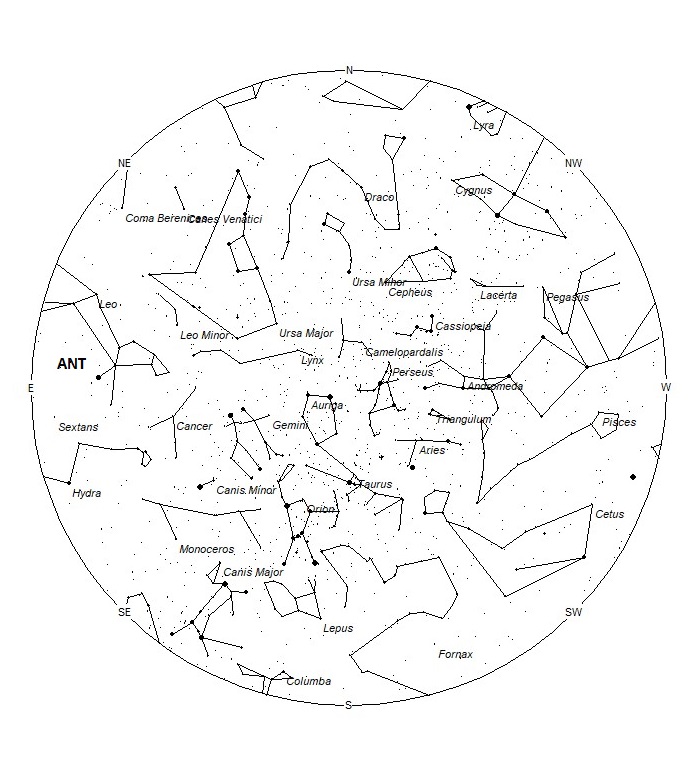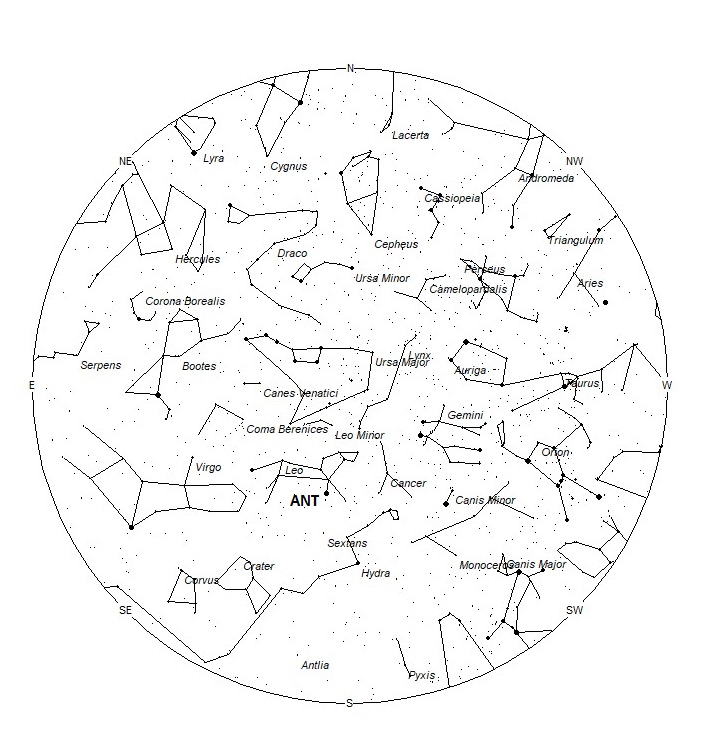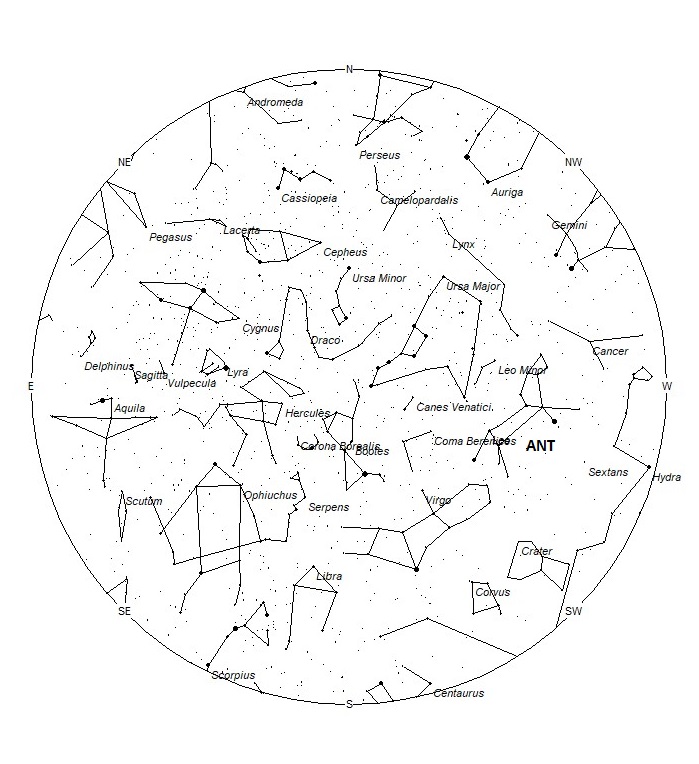During this period, the moon reaches its first quarter phase on Friday February 19th. This weekend the slender waxing crescent moon will set during dusk, leaving the remainder of the night free of interfering moonlight. The estimated total hourly meteor rates for evening observers this week is near 4 as seen from mid-northern latitudes and 6 as seen from tropical southern locations (25S). For morning observers, the estimated total hourly rates should be near 10 as seen from mid-northern latitudes (45N) and 20 as seen from tropical southern locations (25S). The actual rates will also depend on factors such as personal light and motion perception, local weather conditions, alertness, and experience in watching meteor activity. Note that the hourly rates listed below are estimates as viewed from dark sky sites away from urban light sources. Observers viewing from urban areas will see less activity as only the brighter meteors will be visible from such locations.
The radiant (the area of the sky where meteors appear to shoot from) positions and rates listed below are exact for Saturday night/Sunday morning February 13/14. These positions do not change greatly day to day so the listed coordinates may be used during this entire period. Most star atlases (available at science stores and planetariums) will provide maps with grid lines of the celestial coordinates so that you may find out exactly where these positions are located in the sky. A planisphere or computer planetarium program is also useful in showing the sky at any time of night on any date of the year. Activity from each radiant is best seen when it is positioned highest in the sky, either due north or south along the meridian, depending on your latitude. It must be remembered that meteor activity is rarely seen at the radiant position. Rather they shoot outwards from the radiant, so it is best to center your field of view so that the radiant lies at the edge and not the center. Viewing there will allow you to easily trace the path of each meteor back to the radiant (if it is a shower member) or in another direction if it is sporadic. Meteor activity is not seen from radiants that are located far below the horizon. The positions below are listed in a west to east manner in order of right ascension (celestial longitude). The positions listed first are located further west therefore are accessible earlier in the night while those listed further down the list rise later in the night.
These sources of meteoric activity are expected to be active this week.
.
The Anthelion (ANT) radiant is active from a position located at 10:32 (158) +09. This position lies in central Leo, near the spot occupied by the 4th magnitude star known as rho Leonis. Since this radiant is a very large oval, some thirty degrees wide by fifteen degrees high, activity from this radiant can appear from more than one constellation., This week these meteors can also be seen from the constellation of Sextans as well as Leo. The position listed here is for the center of the radiant. This radiant is best placed near 01:00 Local Standard Time (LST) when it lies on the meridian and is highest in the sky. Rates at this time should be near 3 per hour no matter your location. With an entry velocity of 30 km/sec., the average Anthelion meteor would be of slow velocity.
The alpha Centaurids (ACE) are active from February 3-20, with maximum activity occurring on February 9th. The radiant is currently located at 14:28 (217) -60. This position lies in southeastern Centaurus, directly between the two brilliant stars known as Rigel Kentaurus (alpha Centauri) and Hadar (beta Centauri). Due to the southern declination of this radiant, these meteors are not well seen in the northern hemisphere. Current hourly rates are expected to be less than 1 as seen from the northern hemisphere and near 5 as seen from the mid-southern hemisphere. These meteors are best seen near 05:00 LST when the radiant lies highest above the horizon. At 56 km/sec. the alpha Centaurids would produce mostly swift meteors.
As seen from the mid-northern hemisphere (45N) one would expect to see approximately 7 sporadic meteors per hour during the last hour before dawn as seen from rural observing sites. Evening rates would be near 3 per hour. As seen from the tropical southern latitudes (25S), morning rates would be near 12 per hour as seen from rural observing sites and 4 per hour during the evening hours. Locations between these two extremes would see activity between the listed figures.
The list below offers the information from above in tabular form. Rates and positions are exact for Saturday night/Sunday morning except where noted in the shower descriptions.
| SHOWER | DATE OF MAXIMUM ACTIVITY | CELESTIAL POSITION | ENTRY VELOCITY | CULMINATION | HOURLY RATE | CLASS |
| RA (RA in Deg.) DEC | Km/Sec | Local Standard Time | North-South | |||
| Anthelion (ANT) | – | 10:32 (158) +09 | 30 | 01:00 | 3 – 3 | II |
| alpha Centaurids (ACE) | Feb 09 | 14:28 (217) -60 | 56 | 06:00 | <1 – 5 | II |








